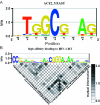enoLOGOS: a versatile web tool for energy normalized sequence logos - PubMed (original) (raw)
enoLOGOS: a versatile web tool for energy normalized sequence logos
Christopher T Workman et al. Nucleic Acids Res. 2005.
Abstract
enoLOGOS is a web-based tool that generates sequence logos from various input sources. Sequence logos have become a popular way to graphically represent DNA and amino acid sequence patterns from a set of aligned sequences. Each position of the alignment is represented by a column of stacked symbols with its total height reflecting the information content in this position. Currently, the available web servers are able to create logo images from a set of aligned sequences, but none of them generates weighted sequence logos directly from energy measurements or other sources. With the advent of high-throughput technologies for estimating the contact energy of different DNA sequences, tools that can create logos directly from binding affinity data are useful to researchers. enoLOGOS generates sequence logos from a variety of input data, including energy measurements, probability matrices, alignment matrices, count matrices and aligned sequences. Furthermore, enoLOGOS can represent the mutual information of different positions of the consensus sequence, a unique feature of this tool. Another web interface for our software, C2H2-enoLOGOS, generates logos for the DNA-binding preferences of the C2H2 zinc-finger transcription factor family members. enoLOGOS and C2H2-enoLOGOS are accessible over the web at http://biodev.hgen.pitt.edu/enologos/.
Figures
Figure 1
Examples of input weight matrices (horizontal and vertical).
Figure 2
Example of C2H2-enoLOGOS and enoLOGOS output. In this example, the _x_-axis of the C2H2-enoLOGOS output (top) represents the ‘contacting’ amino acid positions of fingers 3, 2 and 1, respectively. The output of web tool enoLOGOS (bottom) contains a grey-scale-coded matrix plot of the mutual information of each pair of positions of the alignment.
Similar articles
- Skylign: a tool for creating informative, interactive logos representing sequence alignments and profile hidden Markov models.
Wheeler TJ, Clements J, Finn RD. Wheeler TJ, et al. BMC Bioinformatics. 2014 Jan 13;15:7. doi: 10.1186/1471-2105-15-7. BMC Bioinformatics. 2014. PMID: 24410852 Free PMC article. - Phylo-mLogo: an interactive and hierarchical multiple-logo visualization tool for alignment of many sequences.
Shih AC, Lee DT, Peng CL, Wu YW. Shih AC, et al. BMC Bioinformatics. 2007 Feb 24;8:63. doi: 10.1186/1471-2105-8-63. BMC Bioinformatics. 2007. PMID: 17319966 Free PMC article. - LogoJS: a Javascript package for creating sequence logos and embedding them in web applications.
Pratt H, Weng Z. Pratt H, et al. Bioinformatics. 2020 Jun 1;36(11):3573-3575. doi: 10.1093/bioinformatics/btaa192. Bioinformatics. 2020. PMID: 32181813 Free PMC article. - MetaLogo: a heterogeneity-aware sequence logo generator and aligner.
Chen Y, He Z, Men Y, Dong G, Hu S, Ying X. Chen Y, et al. Brief Bioinform. 2022 Mar 10;23(2):bbab591. doi: 10.1093/bib/bbab591. Brief Bioinform. 2022. PMID: 35108357 Free PMC article. - Subfamily logos: visualization of sequence deviations at alignment positions with high information content.
Beitz E. Beitz E. BMC Bioinformatics. 2006 Jun 21;7:313. doi: 10.1186/1471-2105-7-313. BMC Bioinformatics. 2006. PMID: 16790056 Free PMC article.
Cited by
- Zinc finger binding motifs do not explain recombination rate variation within or between species of Drosophila.
Heil CS, Noor MA. Heil CS, et al. PLoS One. 2012;7(9):e45055. doi: 10.1371/journal.pone.0045055. Epub 2012 Sep 18. PLoS One. 2012. PMID: 23028758 Free PMC article. - UniPROBE: an online database of protein binding microarray data on protein-DNA interactions.
Newburger DE, Bulyk ML. Newburger DE, et al. Nucleic Acids Res. 2009 Jan;37(Database issue):D77-82. doi: 10.1093/nar/gkn660. Epub 2008 Oct 8. Nucleic Acids Res. 2009. PMID: 18842628 Free PMC article. - Functional pathway mapping analysis for hypoxia-inducible factors.
Chuang CS, Pai TW, Hu CH, Tzou WS, Dah-Tsyr Chang M, Chang HT, Chen CC. Chuang CS, et al. BMC Syst Biol. 2011 Jun 20;5 Suppl 1(Suppl 1):S3. doi: 10.1186/1752-0509-5-S1-S3. BMC Syst Biol. 2011. PMID: 21689478 Free PMC article. - Structural basis of ECF-σ-factor-dependent transcription initiation.
Lin W, Mandal S, Degen D, Cho MS, Feng Y, Das K, Ebright RH. Lin W, et al. Nat Commun. 2019 Feb 12;10(1):710. doi: 10.1038/s41467-019-08443-3. Nat Commun. 2019. PMID: 30755604 Free PMC article. - Dissecting the role of PfAP2-G in malaria gametocytogenesis.
Josling GA, Russell TJ, Venezia J, Orchard L, van Biljon R, Painter HJ, Llinás M. Josling GA, et al. Nat Commun. 2020 Mar 20;11(1):1503. doi: 10.1038/s41467-020-15026-0. Nat Commun. 2020. PMID: 32198457 Free PMC article.
References
- Schneider T.D., Stormo G.D., Gold L., Ehrenfeucht A. Information content of binding sites on nucleotide sequences. J. Mol. Biol. 1986;188:415–431. - PubMed
- Bulyk M.L., Gentalen E., Lockhart D.J., Church G.M. Quantifying DNA–protein interactions by double-stranded DNA arrays. Nat. Biotechnol. 1999;17:573–577. - PubMed

